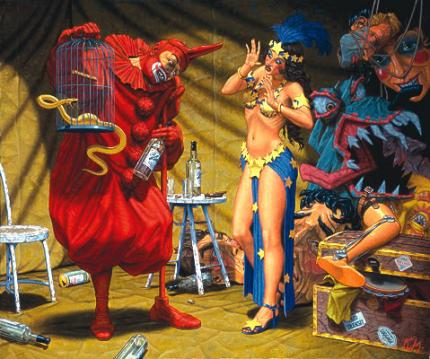In The Pavilion of The Red Clown
If you would like to order multiple prints please email us directly and we will send you an invoice with a single shipping charge
NEARING SOLD OUT STATUS
Same size of the original painting.
One of Williams' largest limited edition images.
Matt to edge of image showing no white border.
Robert Williams Masterpiece.
It has been very fashionable of late, to cast the clown in the persona of a phantom psychopath—a thrilling notion that mixes Halloween with psychiatry. In the mode of antisocial circus performers, little investigation is given to the psychological makeup of clowns themselves. But here, in this painting, it is hard to ignore the personality quirks of this comedian.
A full description of the painting would be in order. This tableau-vivant takes place in a circus tent, obviously the quarters of our red clown. The back drop and floor are made up of olive-tan canvas. This material serves two functions. First, it gives the observer the impression that everything about the environment is transient, ready to be moved to the next location. And secondly, the surrounding canvas has a green tint which emphasizes the image of the clown’s red costume. It might be pointed out that this carmine red figure of derision and the similarity to the devil is no coincidence.
In the tent, as incidentals, is a trunk, along with papier mâché masks and grotesque, illogical theatrical props. The furniture is sparse and the floor is littered with wine bottles. The clown stands posed with a bird cage in hand. This raises the question, “Where is the bird?” He boldly smiles at the visiting show girl, as he alarms her with the cage’s contents. It is occupied with a harmless yellow corn snake. This is the visual structure of the oil painting.
This melodramatic scene was paraphrased with these remarks: “Occupying the cerebral netherworld between humor and severity, the scarlet clad anti-Puck, clowns around as sole purveyor of an abstract levity with ambiguous jokes that seem audienceless.”
This last quotation sheds light on the clown’s bizarre psychology. If you haven’t noticed, the clown has only one leg. He has apparently adjusted to this infirmity and incorporated it into his act. His thin left leg, wearing a red shoe, is actually his crutch. Lying on his steamer trunk is his formal prosthesis used for everyday life. The floor is strewn with booze bottles—he is apparently an unrepentant alcoholic—but that would be a simple situation if his psychosis ended there. It is obvious that he is an experienced master comedian. His costume is the classical European Scaramouche style with a half-mask nose. And of course, he wears the mask drawn back on his forehead with the long nose protruding like a horn, knowingly making himself look ominous.
Two things are unmistakable. To begin with, he delights in the girl’s shock, with her surprise in the bird cage. And, his condition—he’s drunk. It is evident that this character has a second life; however, what is not so conspicuous is that this performer probably functions secretly as another clown, a more inculpable form of buffoon. The girl’s presence in his tent is not only stimulating to him, but is not an accident. Her lure to his web was, no doubt, consensual.
This clown, when not entertaining a layman public, has conditioned himself, over the period of a long career, to mentally slip into a sardonic demi-humor—this is a joke realm more suited to extreme irony with a lack of moral logic. Here is a statement from the painting’s prologue verifying this: “Those private moments shared when a rubber chicken is given a Fleet enema.”
Even detractors to this artwork realize that his image seems to have meaning beyond this graphic melodrama. Looking at the birdcage, the question remains, “Where is the bird?” The show girl instantly knew—it’s in the snake.
—Robert Williams
